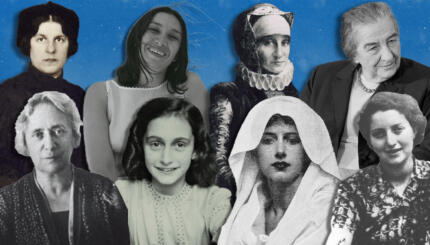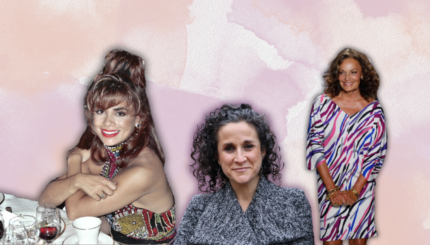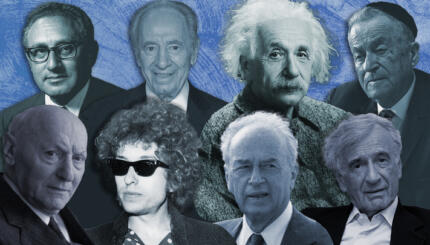It’s strange but true that being a woman made me uniquely positioned to write my historical novels. Growing up a secular Jew, I doubt I would have been inclined to study Talmud if I were a man. But knowing the yeshiva world was still pretty much closed to women in 1992, I jumped at an opportunity to study this forbidden text in a women’s Talmud class. There, I became so intrigued by the legend that Rashi’s daughters were learned back in what many consider the Dark Ages that I decided to find out if it was true. As I researched the legend, I discovered a mistake in a Jewish encyclopedia that only a woman would notice, and this discovery set me on the course to write my Rashi’s Daughters trilogy.
Before I could determine if Rashi’s daughters were really learned, I needed to know who they were. Rashi himself never mentions his daughters, but all his biographies agreed that they were Joheved, Miriam, and Rachel. They also agreed that Rashi, aka Solomon ben Isaac, was born in 1040 C.E., died in 1105 C.E., and that his oldest grandson Isaac, son of Joheved and her husband Meir, was born in 1076 C.E.
Here’s when I came across something odd in an old Jewish Encyclopedia. In the section on Rashi, it stated that Joheved’s four sons were Isaac (named after Rashi’s father), Samuel (named after Meir’s father), Jacob (known as Rabbenu Tam), and Solomon – born after Rashi’s death and named for his grandfather.
As I pondered this, I began to suspect that something was wrong. For if this were true, it would mean that Joheved had children born thirty years apart (the first in 1076 and the last after 1105)! Now I’d done enough genealogy during the “Roots” craze of the 1980s to know that in the days before modern medicine, this was highly unlikely. Men might sire children over a thirty-year period or longer, but not women.
Determined to get to the bottom of this, I consulted every piece of information on Rashi, his daughters, and his illustrious grandsons that I could find. All this research not only turned up evidence that the daughters were indeed learned, but also proved I was correct to question that encyclopedia entry. I learned that Joheved and Meir’s youngest son was actually Jacob, born in 1100, not Solomon as the encyclopedia had posited. I also saw that it was common at this time for Jewish children, both in Ashkenaz and Sepharad, to be named after a living grandparent. I eventually came to the conclusion that the man who’d written that encyclopedia biography had apparently taken the modern Ashkenazi tradition of not naming a child like this and transposed it to the eleventh century where it didn’t belong. Clearly he never considered how old Joheved would have been when baby Solomon was born, or if he did, it didn’t make him skeptical.
Buoyed with the astonishing knowledge that an encyclopedia could be wrong, I decided to use everything else I’d learned to write about Rashi’s daughters myself and set the record straight.
The expertise I acquired from researching Rashi’s family enabled me to delve into the Talmud for information about Rav Hisda, his daughter and her two husbands, plus the rest of the fourth-century Babylonian rabbinic community, in order to write my latest books,
Enchantress: A Novel of Rav Hisda’s Daughter
and
Apprentice: A Novel of Love, the Talmud and Sorcery
.
The Talmud, also known as the Oral Torah, wasn’t written down until hundreds of years after it was compiled. Birth and death dates of Talmudic rabbis were calculated by medieval scholars even later, so after what happened with Joheved’s son Solomon, I was prepared to challenge anything dubious. Indeed, my suspicions that some of these dates might be wrong were confirmed when I tried to sort out Rav Hisda’s family. In particular, I ran into trouble determining when his daughter, my heroine, was born.
All of Rav Hisda’s biographies, including the most recent edition of Encyclopedia Judaica, hold that Hisda was born in 217 C.E. and died in 309 C.E. The Talmud states quite clearly that he married at age sixteen, but because young men rarely married older women and most girls wed shortly after reaching puberty, I figured his wife would have been born around 219 C.E. This woman, his only wife, gave Hisda nine children who lived to adulthood and was still married to him well into her sixties.
These same sources give the birth year for his son-in-law Rava, my heroine’s second husband, as approximately 275 C.E. Do you see the difficulty? Even if my heroine was Hisda’s youngest child, she could not have been born later than 265 C.E. For a man to marry a woman ten years his senior is unusual enough, but to further complicate things, we know from another section of Talmud that Hisda’s daughter was a young girl at the time that Rava was her father’s student, so she must have been younger than her future husband.
How did I resolve this contradiction, one only a woman would question?
I did what the Gemara does when it cannot explain a contradiction between two Mishnas any other way: it revises one Mishna’s text so they both make sense. I felt more comfortable giving precedence to information found in the Talmud itself than relying on guestimates from five hundred years later. So in my book, I wrote that Rav Hisda was born in 230 C.E., his daughter in 275 C.E., and Rava in 270 C.E. Problem solved.
But I didn’t rest there. When I learned in 2005 that a new edition of Encyclopedia Judaica was in the works, I contacted one of their editors who was familiar with my work to ensure that their Rashi article would not perpetuate this error. I also became a Wikipedia editor, where I monitor their articles on the historical figures in my novels for accuracy. It’s important that women’s scholarship isn’t seen as limited to researching historical novels, or worse, overlooked entirely.
Ashkenazi
Pronounced: AHSH-ken-AH-zee, Origin: Hebrew, Jews of Central and Eastern European origin.
Gemara
Pronounced: guh-MAHR-uh, Origin: Aramaic, a compendium of rabbinic writings and discussions from the first few centuries of the Common Era. The Talmud comprises Gemara and the Mishnah, a code of law on which the Gemara elaborates.
Talmud
Pronounced: TALL-mud, Origin: Hebrew, the set of teachings and commentaries on the Torah that form the basis for Jewish law. Comprised of the Mishnah and the Gemara, it contains the opinions of thousands of rabbis from different periods in Jewish history.
yeshiva
Pronounced: yuh-SHEE-vuh or yeh-shee-VAH, Origin: Hebrew, a traditional religious school, where students mainly study Jewish texts.



